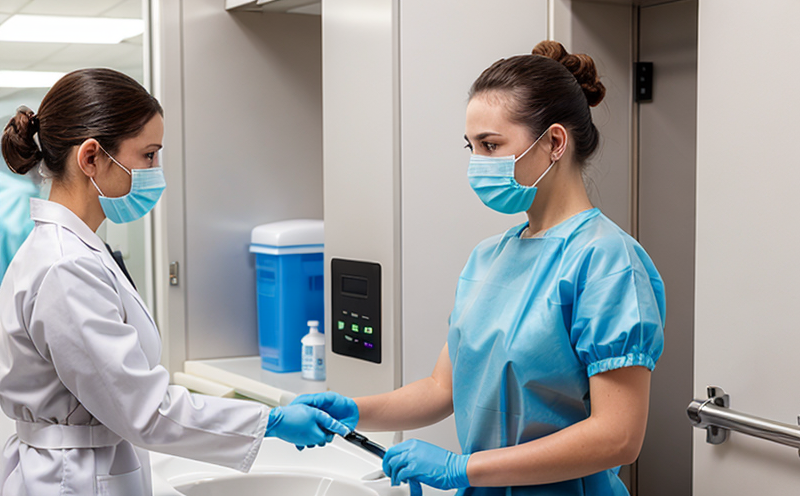AATCC 147 Parallel streak method for antibacterial testing
The AATCC 147 parallel streak method is a standardized procedure used to evaluate the antimicrobial efficacy of textiles, particularly focusing on their ability to inhibit bacterial growth. This test is essential for manufacturers, quality managers, and compliance officers who need to ensure that their products meet stringent hygiene standards set by international regulations.
The primary objective of this method is to determine whether a textile can effectively reduce or eliminate bacteria when exposed to it. The procedure involves exposing the fabric sample to a bacterial suspension under controlled conditions and then assessing the extent of bacterial growth on different parts of the sample using streak lines. This allows for precise quantification of the antimicrobial activity.
The AATCC 147 method is widely recognized in the textile industry as it provides a reliable means of measuring the antibacterial performance of fabrics, which is crucial for ensuring product safety and efficacy. Compliance with this standard ensures that textiles can be used safely by consumers without posing risks from microbial contamination.
The test setup typically involves preparing bacterial cultures according to ISO 6883-1:2015, selecting appropriate strains such as Staphylococcus aureus or Escherichia coli, and inoculating the samples with these microorganisms. The fabric is then incubated under specific conditions that simulate real-world use scenarios, allowing for accurate evaluation of its antimicrobial properties.
Once the test period has concluded, the samples are visually inspected along parallel streak lines drawn across them prior to exposure. Any visible differences in bacterial growth patterns between exposed and non-exposed areas indicate effective antibacterial action by the fabric.
This testing method is particularly useful for research and development (R&D) engineers working on new generations of textiles designed specifically with hygiene in mind. It also plays a critical role in procurement processes where suppliers need to demonstrate adherence to industry best practices regarding microbial resistance.
In summary, AATCC 147 provides a robust framework for evaluating the antibacterial properties of various types of textile materials. By adhering to this standard, manufacturers can produce safer products that meet both regulatory requirements and consumer expectations concerning hygiene and health.
- Reproducibility: Results obtained from different laboratories should be consistent if proper techniques are followed.
- Absolute Quantification: The method allows for precise quantification of bacterial reduction percentages after exposure.
- Strain Specificity: Different strains respond differently to specific fabrics, providing insights into material efficacy against particular pathogens.
Benefits
The adoption of the AATCC 147 parallel streak method brings numerous advantages to various stakeholders within the textile industry. Quality managers gain peace of mind knowing that their products meet high safety standards, while compliance officers ensure they stay ahead of regulatory changes.
R&D engineers benefit from this testing protocol by having a standardized approach to developing innovative solutions aimed at enhancing hygiene attributes of fabrics. Procurement teams can confidently select suppliers based on rigorous performance metrics provided through these tests.
For consumers, the availability of textiles that pass stringent antimicrobial assessments translates into greater confidence in purchasing decisions related to personal safety and well-being.
The use of AATCC 147 ensures consistency across manufacturing processes and helps maintain brand reputation by consistently delivering products that exceed industry expectations. Additionally, it facilitates easier market entry into regions where strict hygiene regulations apply.
Quality and Reliability Assurance
The AATCC 147 method plays a vital role in maintaining quality assurance throughout the entire lifecycle of textile products. By ensuring that all samples are tested under identical conditions, manufacturers can identify any inconsistencies early on and make necessary adjustments before large-scale production begins.
- Consistent Results: The standardized nature of this test guarantees uniformity across multiple trials conducted by different labs.
- Accurate Evaluation: Properly executed tests provide accurate data regarding the effectiveness of antimicrobial treatments applied to fabrics.
- Compliance Verification: Adherence to international standards like AATCC 147 helps companies avoid penalties associated with non-compliant products.
Through regular quality checks using this method, businesses can continuously improve their offerings, thereby enhancing overall customer satisfaction levels. Moreover, consistent compliance minimizes risks related to potential recalls or lawsuits due to unsafe products reaching consumers.
Environmental and Sustainability Contributions
The AATCC 147 parallel streak method contributes positively towards environmental sustainability by promoting the development of more sustainable textiles. By encouraging innovation in fabric design that focuses on improved hygiene without compromising other eco-friendly attributes, this testing methodology indirectly supports greener practices within the industry.
Manufacturers who adopt sustainable approaches while still ensuring effective antimicrobial properties contribute significantly to reducing waste and minimizing environmental impact associated with conventional methods of cleaning fabrics after usage. Furthermore, the reduced need for post-consumer washing due to inherent hygiene features translates into lower energy consumption during production processes.
Consumers also play a crucial role in fostering sustainability by choosing products that have undergone rigorous antimicrobial testing according to recognized standards like AATCC 147. This collective effort promotes circular economy principles and supports responsible resource management practices across supply chains.





